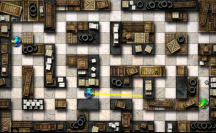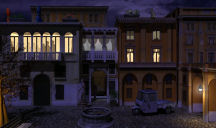Nancy Drew enters an underground room,
dimly lit and lined with rusted pipes, gauges and dials. The door slams
behind her. A rushing sound and water pours into the room. Trapped! Has
our heroine’s luck finally run out? Is there any hope of escape?
Enchant us Once Again
Thus begins Ms. Drew’s eighteenth mystery adventure, The Phantom of
Venice.
The dramatic opening sequence is followed by a flashback -- gameplay
commences at the point, earlier in the week, when Nancy first arrives in
Venice. Nancy has flown to Italy at the instigation of her aristocratic
friend, Prudence Rutherford (from Nancy Drew: The Secret of the
Scarlet Hand). Nancy is working with the Italian police, who are
investigating a series of recent art-related thefts. Wearing a mask and
cape, the criminal, dubbed “The Phantom,” has been stealing historical
works – a golden chalice, a Guttenberg Bible, and an original score of
Verdi’s Rigoletto.
No one knows the Phantom’s identity or how he manages to overcome
complicated security systems. Nancy takes up residence in a boarding house
formerly owned by Prudence Rutherford and tries to solve the mystery that
has stymied the police.
Masquerade! Every Face a Different Shade…
In keeping with the local Carnevale Di Venezia, our heroine soon
encounters other masked characters drawn from the Commedia dell’Arte. The
costumes and classical names of these theatrical figures not only disguise
their wearers’ true identities, but also contribute to an atmosphere of
opulence (tinged with menace).
The mask theme also suits the people Nancy meets who aren’t wearing
costumes or masks. As events unfold, it becomes apparent that hidden
agendas and false identities are second nature to the sophisticated
Venetians. As you can imagine, the dramatic tension in Phantom
revolves around figuring out who can – and can’t – be trusted. Not to be
outdone, Nancy assumes two aliases to further her own investigation.
Phantom contains a memorable cast. Colin Baxter is a handsome
expat Brit. He’s a restoration expert with a desire to do justice to the
artworks he’s restoring while satisfying the demands of his employer (and
harboring a growing affection for a certain undercover detective). Then
there’s the social climbing widow with a veneer of respectability, the
beautiful journalist who has befriended all the Venetian movers and
shakers, and the card-playing man in the mask who judges people by their
skill at Scopa.
Voiceovers are very good – a surprise since the Italian accent is one
of the most caricatured in movies and games. In Phantom, the broad
“Luigi and Mario” type of accent occurs in only one place, and is
associated with a tech device rather than a person. Lip sync is accurate
and facial expressions are subtle and natural. The dialogs are well
written and suit each character. But they can’t be clicked through, so
that at times I sat just waiting for them to end.
Lani Minella reprises her now-famous role as the game’s heroine,
managing to be intelligent, perky, and relentless all at the same time. In
Phantom Nancy seems more grown up than in the previous games I’ve
played, perhaps because she is on her own in a foreign city and the tasks
required of her are riskier. I enjoyed Nancy’s increased maturity.
If it's Loudly Sung and in a Foreign Tongue…
Venice wouldn’t be Venice without gondoliers, and plenty appear in the
game. You can elect to move about the gameworld via gondola, paying extra
to hear the gondoliers sing. When you pay, you’re treated to a photo and
animation montage of the canals of Venice. I spent a leisurely stretch
riding with the gondoliers, admiring the water, sky, and architecture
while listening to their songs.
The graphics in Phantom are vivid and detailed, though a trifle
hazy when using the wide-screen graphical option. A few locations have
360-degree panning, but in others you must use the 180-degree turn icon –
the game doesn’t allow you to see what’s on Nancy’s left or right, but
only what’s ahead and what’s behind. Venice really comes to life in
depictions of leaf-strewn courtyards, rooms with a view, bright but
weatherworn surfaces, nuanced shadows and quaint furnishings.
The background music varies from jaunty walking music to dissonant
tones that evoke a sense of formless dread. Ambient sounds also contribute
to the atmosphere. In Venice, of course, there are all kinds of water
sounds – lapping, dripping, and splashing. In the piazzas you’ll hear
footfalls, pigeons cooing and random conversations in Italian.
Who was that Shape in the Shadows?
This game cleverly relies on the layout of Venice and aspects of
Italian culture to create a variety of challenges. For example, in one
sequence, Nancy uses the game map to track a moving object throughout the
available locations, partly on foot and partly via canal. Another example:
the Italian language is used as a puzzle in one sequence where undercover
policemen are mere shadows in the landscape, just as the Phantom is. As
the police tell Nancy their locations in Italian, Nancy tries to find the
Phantom by process of elimination.
For puzzle traditionalists, the game includes code-solving puzzles, an
unusual chess puzzle, plus a few mechanical and inventory manipulation
challenges. Ms. Drew must also monitor her financial resources –
particularly if she takes lots of gondola rides, buys extra clothing, or
indulges in the pleasures of gelato (a kind of ice cream). If overspending
becomes a problem, Nancy has several ways to make more money, including
auditioning as a dancer. Nancy’s dance routine is a hoot to watch, as she
has to execute “groovy” dance movements (The Monkey, The Cher, The Twist,
etc.) while the director critiques her performance. The dance sequence is
also timed, which makes it fairly difficult. I humiliated poor Nancy by
seeing to it that she earned lots of money in this undignified fashion.
You will encounter other timed movement challenges in Phantom.
Some you probably won’t complete without failing a few times. Failure
results in a quick description of why Ms. Drew is sent back home; then you
are returned to the point immediately before you failed. With one
exception, I did not find the timed challenges to be so difficult as to
become annoying. The exception was a timed sequence near the end where the
goal can only be reached through trial and error. In my experience, when
significant experimentation is required, a timer exponentially increases
the gamer’s frustration.
In fact, this is the first adventure game I’ve played in which I
found myself actually enjoying some of the time sensitive challenges. I
didn’t mind trying the dance sequence again and again, for instance,
because I was enjoying the process itself. Perhaps the frustration with
timed challenges is not just that the gamer has to move quickly, but that
the activity itself is often so tedious. Still, this game would have been
even better if it had provided an option for bypassing the timed sequences
after a certain number of failures.
Phantom features a surprisingly entertaining stealth sequence,
done from a top-down perspective. Another fun challenge is the colorful
card game Scopa, which involves a bit of strategy and some simple math.
For the sheer enjoyment, I played many more hands than were necessary to
finish the overall game.
I had a grand old time in Venice with the charmingly versatile Ms.
Drew.
Make Your Choice
This is a point-and-click adventure, played from the first person
perspective, with easy navigation from screen to screen. The inventory is
simple to use. I encountered only one minor glitch – a hotspot that
disappeared after I used the binoculars with it (the binoculars worked
again without the hotspot, so this glitch didn’t create a dead end).
The game can be played at either the Junior or Senior Detective Level.
The Junior Level provides a checklist and occasional phone clues that can
get you moving if you are stuck. Unless you are a hardcore adventure game
achiever, I recommend the Junior Detective Level. A thorough tutorial at
the beginning of the game is a great feature if you haven’t played any of
the earlier Nancy Drew games. You need not have played any of Ms. Drew’s
previous games in order to enjoy this one.
Many Notes from Nancy Drew: The Phantom of Venice
A lively mystery game suitable for all ages. One of the best games in
the Nancy Drew series. First person perspective, point-and-click
interface.
A special commendation should go to the designers, who have provided a
variety of entertaining puzzles, some influenced by the city of Venice and
by Italian culture and language. Inventory and logic puzzles, code
breaking, a particularly fun card game, many timed puzzles. No sliders,
two mazes. One sound matching puzzle. It will be difficult to finish the
game if you have trouble distinguishing colors. The inventory is easy to
use.
Two of the most difficult puzzles – a maze with a structure reminiscent
of a “Towers of Hanoi” puzzle and a fax machine challenge that requires
patience and analytical skill.
Colorful, elaborate environments, giving a good sense of the sumptuous
city of Venice. Characters with distinct personalities and many secrets to
hide. Enjoyable dialogs, good voiceovers.
Nancy can’t die, but she does fail – the game takes you right back to
the moment before the failure. One minor hotspot glitch. No problems with
installation. A good, optional opening tutorial. Unlimited save slots.
Nancy Drew: The Phantom of Venice is aimed at the many of fans
of Ms. Drew, but also at any gamer who likes a good mystery, devious
characters, and clever, sometimes time sensitive challenges.
Final Grade: A-
Note: section headings are from Andrew Lloyd Webber’s “Phantom of the
Opera,” lyrics by Charles Hart and Richard Stilgoe.
August 2008
design copyright ©
2008
GameBoomers
Group




